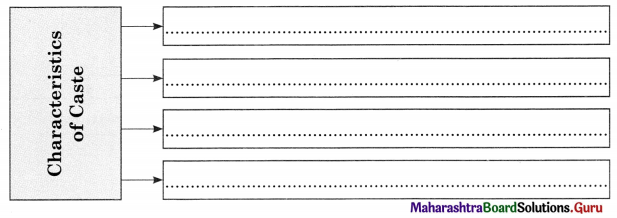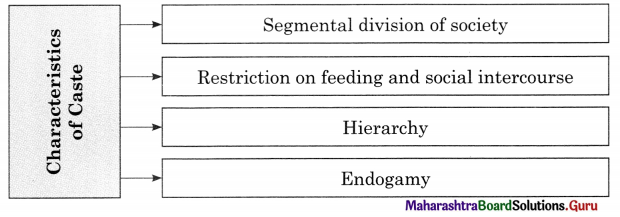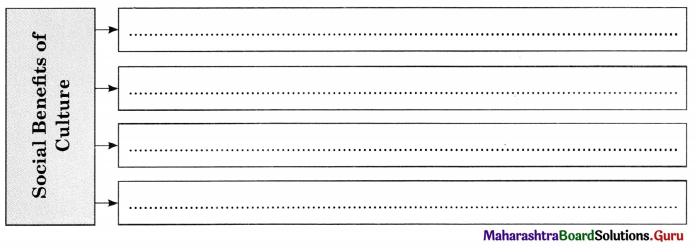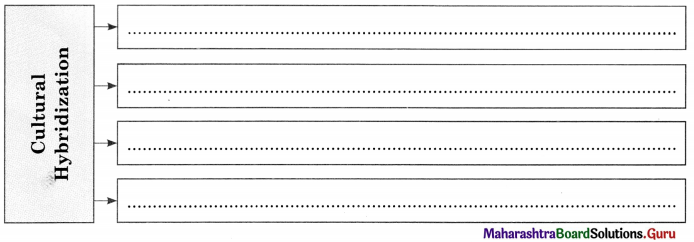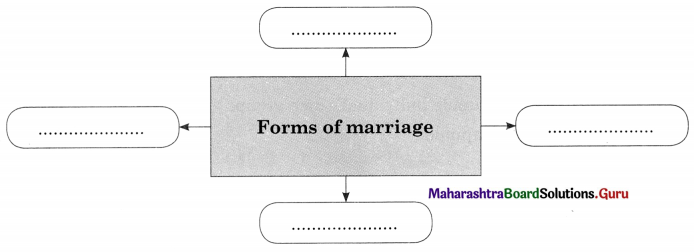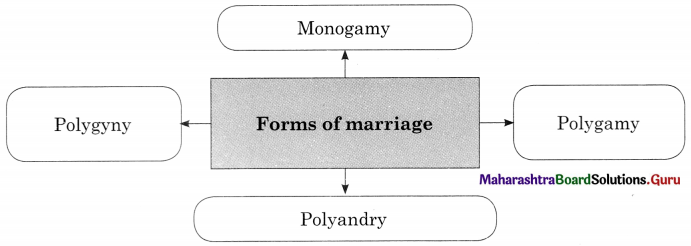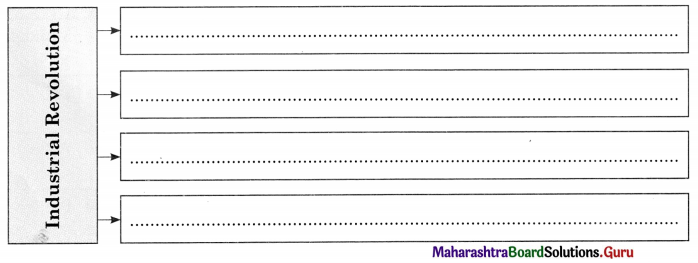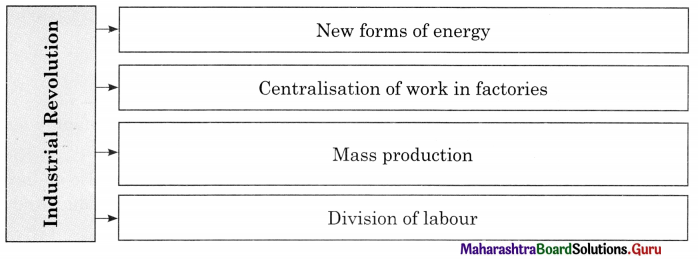Balbharti Maharashtra State Board Class 11 Sociology Important Questions Chapter 8 Social Change Important Questions and Answers.
Maharashtra State Board 11th Sociology Important Questions Chapter 8 Social Change
Choose the correct alternative and complete the statements.
Question 1.
Changes in the ………………… of society have an impact on social relationships.
(direction / structure / nature)
Answer:
structure
Question 2.
Changes that take place in several directions at the same time is known as …………………
(linear / multi-linear / cyclical)
Answer:
multi-linear

Question 3.
Styles of dressing which was popular few generations ago have become popular today is an example of ………………… change.
(linear / cyclical / multi-linear)
Answer:
cyclical
Question 4.
………………… compares society to a biological organism.
(Auguste Comte / Herbert Spencer / Max Weber)
Answer:
Herbert Spencer
Question 5.
Social change is …………………, as it denotes a time sequence.
(temporal / complex / immoral)
Answer:
temporal
Question 6.
Giving up social evils like dowry or early marriage is an example of ………………… change.
(long-term / short-term / neutral)
Answer:
long-term
Question 7.
………………… change happens suddenly.
(Planned / Unplanned / Temporal)
Answer:
Unplanned
Question 8.
………………… factor is also known as geographical or natural factor.
(Cultural / Economic / Physical)
Answer:
Physical
Question 9.
The physical environment has also been adversely affected by human behaviour in the name of …………………
(displacement / conditions / development)
Answer:
development
Question 10.
…………….. factor is also known as demographic factor.
(Biological / Physical / Social)
Answer:
Biological
Question 11.
……………….. is defined as the number of females per thousand males in any given population.
(Demography / Sex ratio / Fertility)
Answer:
Sex ratio
Question 12.
………………… development is affected by size of population.
(Socio-psychological / Socio-economic / Socio-cultural)
Answer:
Socio-economic
Question 13.
………………… showed an interrelation between the teachings of Protestant religion and spread of capitalism in Europe.
(Karl Marx / Auguste Comte / Max Weber)
Answer:
Max Weber
Question 14.
……………….. conflict has resulted in class-conflict.
(Social / Economic / Cultural)
Answer:
Economic
Question 15.
The LPG Policy was adopted by the government in …………………
(1971 / 1991 / 1994)
Answer:
1991
Question 16.
………………… development is an index of the overall progress of society.
(Cultural / Technological / Physical)
Answer:
Technological
Question 17.
………………… is a means to help develop ideas, skills, solve problems and transform people.
(Technology / Knowledge / Education)
Answer:
Education

Question 18.
………………… is a statistical study of human population.
(Migration / Demography / Composition)
Answer:
Demography
Correct the incorrect pair.
Question 1.
(a) Herbert Spencer – Functionalism
(b) Emile Durkheim – Theory of Three Stages
(c) Auguste Comte – Protestant Ethic
(d) Max Weber – Organic Analogy
Answer:
(b) Emile Durkheim – Anomic suicide
Question 2.
(a) YCMOU – University Grant Commission
(b) UGC – Right to Education
(c) RTE – Post Globalization
(d) LPG – Yashwant Chavan Maharashtra Open University
Answer:
(d) LPG – Liberalization, Privatization and Globalization
Question 3.
(a) Max Weber – Cultural Factor
(b) Karl Marx – Economic Factor
(c) Demographic Factor – Technological Factor
(d) The Latur Earthquake – Physical Factor
Answer:
(c) Demographic Factor – Biological Factor
Question 4.
(a) Changes takes place everywhere – Universality .
(b) An endless process – Continuous process
(c) It is amoral – Neutrality
(d) Denotes a time sequence – Chain reaction
Answer:
(d) Denotes a time sequence – Temporal.
Identify the appropriate term from the given options.
(Physical Factor, Educational Factor, Economic Factor, Technological Factor, Demography, Biological Factor, Socio-cultural Factor, Unplanned Factor, Information Age, Planned Change, Migration, Interaction Chain Reaction, Long-term Change.)
Question 1.
Consequences of overpopulation and underpopulation.
Answer:
Biological factor
Question 2.
The growth of large scale industries.
Answer:
Economic factor
Question 3.
Online examination.
Answer:
Technological factor
Question 4.
Cultural diffusion is a source of change.
Answer:
Socio-Cultural factor
Question 5.
A huge increase in school fees, will have an impact on student enrolment
Answer:
Interactional factor
Question 6.
Eradicating strongly embedded customs like dowry, sati system, etc.
Answer:
Long-term change
Question 7.
Definite spaces marked for residences, economic zones, parks etc.
Answer:
Planned change

Question 8.
A statistical study of human population.
Answer:
Demography
Correct the underlined words and complete the sentence.
Question 1.
Emile Durkheim has given us a theory of three stages of human thought.
Answer:
Auguste Comte has given us a theory of three stages of human thought.
Question 2.
Human society is a structure with various parts unrelated.
Answer:
Human society is a structure with various parts interrelated.
Question 3.
Joint families are now undergoing significant changes is an example of functional changes.
Answer:
Joint families are now undergoing significant changes is an example of structural changes.
Question 4.
Social changes take place overnight.
Answer:
Social changes take place over time.
Question 5.
Decrease in school fees may further result in higher ‘drop out’.
Answer:
Increase in school fees may further result in higher ‘drop out’.
Question 6.
Social change is immoral.
Answer:
Social change is amoral.
Question 7.
Social programmes have to be immediately designed and implemented for the natural calamities affected person.
Answer:
Rehabilitation programmes have to be immediately designed and implemented for the natural calamities affected person.
Question 8.
Some purposeful and unplanned changes are promoted by the government and other agencies.
Answer:
Some purposeful and planned changes are promoted by the government and other agencies.
Question 9.
Social change is a result of the interaction of single factors.
Answer:
Social change is a result of the interaction of multiple factors.
Question 10.
Technological factors consist of climatic conditions, bio diversity, natural resources, etc.
Answer:
Physical factors consist of climatic conditions, bio diversity, natural resources, etc.
Question 11.
Social change is to some extent conditioned by religious factors.
Answer:
Social change is to some extent conditioned by physical factors.
Question 12.
The problems of food, housing, unemployment, poverty are problems as well as direct outcomes of changing sex ratio.
Answer:
The problems of food, housing, unemployment, poverty are problems as well as direct outcomes of changing demography.

Question 13.
Economic competition has resulted in class – conflict, increase in capitalism in the society.
Answer:
Economic competition has resulted in class – conflict, increase in materialism in the society.
Question 14.
For Conflict Theorist, culture is considered a basis for change in society.
Answer:
For Conflict Theorist, conflict is considered a basis for change in society.
Question 15.
One of the benchmarks of a so-called civilized society is its extent of cultural development.
Answer:
One of the benchmarks of a so-called civilized society is its extent of technological development.
Question 16.
The government is taking huge efforts to reach to all sections of society through digitalization.
Answer:
The government is taking huge efforts to reach to all sections of society through Right to Education.
Write suitable examples of the given concepts and justify your answer.
Question 1.
Social change.
Answer:
Example : For example, in today’s ‘Information Age’, the role of a teacher in a school is radically different than it was during the early Vedic period. Structural changes always occur in society. For example, with regard to structure in terms of size of family, joint families are now undergoing significant changes. At the same time there are functional changes in the family system. Education was a function of the family previously. Today it has become a specialized function which has been passed on to schools, colleges through a formal means of education.
Social change is a change in the social structure and social relationships of the society. Society change is a continuous, ongoing process. ‘The term’ social change refers to changes that take place in the structure and functioning of social institutions; for example, government education, economy, marriage, family, religion. Social changes also refers to change in performance of social roles of individuals according to changing times.
Question 2.
Long – term change.
Answer:
Example : Giving up social evils like dowry, early marriage or domestic violence. Eradicating strongly embedded customs and practices take decades to get rid of.
Social changes that may take years or decades to produce results are long – term changes. Significant social changes having long-term effects include the industrial revolution, the abolition of slavery etc. social movements play important role in creating awareness and inspiring discontented members of a society to bring about social change.
Question 3.
Unplanned change.
Answer:
Example : Natural calamities such as famine, floods, earthquakes, tsunami, volcanic eruption, etc. are the instances of unplanned changes. Social change which occurs in the natural course is called the unplanned change. The unplanned changes are spontaneous, accidental or the product of sudden decision.
When a natural disaster takes place, there is a loss of human and animal lives as well as property. Rehabilitation programmes have to be immediately designed and implemented for the affected persons. Unplanned change by its very name suggests that it is a type of change that is not planned. It happens suddenly.
Question 4.
Demography.
Answer:
Example : The study of statistics such as births, deaths, income, or the incidence of disease, which illustrate the changing structure of human populations. The problems of food, housing, unemployment, poor health, poverty, low standard of living etc., are problems as well as direct outcomes of changing demography.
Demography is a statistical study of human population. Demography encompasses the study of the size, structure and distribution of the population. It records spatial and temporal changes in population in response to birth, migration, aging and death. The composition of a particular human population is demography.
Question 5.
Direction of social change.
Answer:
Example : Linear Change – Primitive society moving towards a state of industrialism. Multi-linear Change – Cultural diversity.
Cyclical Change – Styles of dressing or hairstyling which were popular few generations ago have become popular today.
Social change is a change in social structure and social relationship of society. Auguste Comte has given us a theory of three stages of human thought. Society change is a continuous process. Sometimes changes proceed from one stage to another in a single direction known as linear change. It may also be a multi-linear change, that is, changes can take place in several different directions at the same time. Then again, the change may be cyclical, that is, human society goes through certain cycle.
Write short notes.
Question 1.
Characteristics of Social Changes.
Answer:
1. Universality : All human societies change. This could include changes in population, beliefs, tools, attire, customs, roles, music, art, architecture etc. Social change is universal as it takes place everywhere. This change is not uniform as it takes place at differing speeds.
2. Continuous speed : There is continuity of change in society. Right from the emergence of human society from the times of nomadic cave dwellers to the present, every aspect of human life and living has changed.
3. Temporal : Social change is temporal as it denotes a time sequence. Innovations of new things, modifications and renovation of the existing phenomena and the discarding of the old takes time.
4. Interactional chain reaction : The physical, biological, technological, cultural, social economic and other factors may together bring about social change. This is due to mutual interdependence of social phenomenon. Thus, for example, a huge increase in school fees will have an impact on student enrolment.
5. Neutrality : The term social change has no value judgment attached to it. As a phenomenon, it is neither moral nor immoral it is amoral. It is ethically neutral.
6. Short term and long-term change : Some social changes may bring about immediate results while some others may take years or decades to produce results. The purchase of new gadgets for the purpose of entertainment is faster if one has the purchasing capacity when compared to giving up social evils like dowry, early marriage or domestic violence.
7. Planned or unplanned changes : Unplanned changes happens suddenly and is not planned. For example, when a natural disaster takes place, there is a loss of human and animal lives as well as property. Rehabilitation programmes, some purposeful and planned changes promoted by the government are examples of planned change.

Question 2.
Socio cultural factor of social change.
Answer:
Human culture is a process of change. A change in the cultural order is accompanied by a corresponding change in the whole social order. Cultural diffusion is a source of change. Culture includes our values, beliefs, ideas and ideologies, morals, customs and traditions. These are all subject to change and they in turn, cause changes. Ideas and cultural values play a crucial role in social change.
German sociologist, Max Weber gave importance to the cultural factor of social change. He showed an interrelation between the teachings of protestant religion and spread of capitalism in Europe, in his famous book “Protestant Ethic and the spirit of Capitalism”. Also, these are negative consequences of ideologies that promote religious fundamentalism, extremist thinking, superstitious beliefs and practices, mindless values; these leads to untold hardships and human miseries. They become stumbling blocks to change.
Question 3.
Technological factor of social change.
Answer:
One of the benchmarks of a so called civilized society is its extent of technological development. Technological development creates new conditions of life and new conditions for adaptation. Technological development continues to be an index of the overall progress of society. Technological changes have affected social, economic, religious, cultural and political life of human beings.
Opportunities for e-learning, e-library, e-commerce, e-ticketing, online marketing, online examination is possible today, due to technological innovations. We live in digitalized age. Digitalization has helped the government to identify many beneficiaries who can be provided aid.
Question 4.
Educational factor and social changes.
Answer:
Education is a means to help develop ideas and skills, solve problems, transform people. People acquire knowledge, skills, develop, competencies and then use these to seek employment or self¬employment. The purpose of education, its content, its pedagogy is changing. Use of technology within education though e-learning, online education, smart boards, virtual classrooms, national digital library etc have brought about far reaching changes even within the field of education.
Many persons have opportunities to learn due to the efforts of the government. A special effort has been made by the University Grants Commission (UGC) to encourage education for trans¬gender persons. Educations can transform people lives.
Question 5.
Economic factor and social changes.
Answer:
This factor is of unique importance in social change. Stages of economic development in human history are not limited to economic transformation in society. They promote large scale political and social transformations. Economic development affects different institutions. The growth of large-scale industries led to employment opportunities, professionalism, exploitation, trade unionism and so forth. Economic competition has resulted in class-conflict increase in materialism in the society. The class divide continues to this day.
For example, peasant movement, women’s movements, labour movements, student movement, tribal movement etc. for conflict theorists – conflict is considered a basis for change in society. Globalization as a process continues to have a huge impact on Indian society. The LPG policy adopted by the government of India in 1991 has led to far reaching consequences on our political institutions, economy, family, education etc.
Differentiate between.
Question 1.
Physical and biological factors of social change.
Answer:
| Physical factor |
Biological factor |
| (i) Physical factor is also known as geographical or natural factor. |
(i) Biological factor is also known as demographic factor. |
| (ii) Physical factors consists of climatic conditions, physical environment, animal life, biodiversity, mineral resources, natural resources, etc. |
(ii) The biological factors lies in the biological conditions of social continuity, the perpetuation, growth or decline of a given population, migration or race. |
| (iii) Social change to some extent conditioned by physical factors. |
(iii) Biological factors bring change in population structure. |
| (iv) Physical factor is modified by man, to meet his needs for example construction, of bridge, dam, highway, road, canal, irrigation etc. |
(iv) Population movement from rural to urban area, and other such demographic changes significantly influence the course of social change in a society. |

Complete the concept maps.
Identify the significant factor of change for each.
Question 1.

Answer:

Question 2.

Answer:

Question 3.
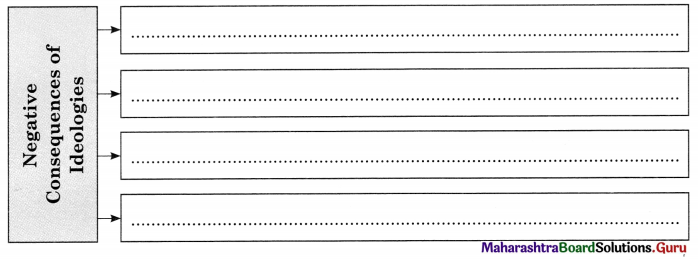
Answer:
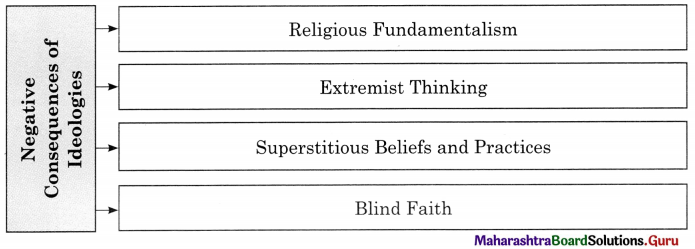
Question 4.

Answer:

Question 5.

Answer:

State whether the following statements are true or false with reasons.
Question 1.
Social change is a complex phenomenon.
Answer:
This statement is True.
- It includes the direction of social change, form of social change, sources of social change, causes of social change, and consequences of social change.
- Any alternation, difference, modification that takes place in a human situation through time, can be called social change.
- A single factor may trigger a particular change, but it is almost associated with other factors due to interdependence of several factors which makes social change a complex phenomenon.

Question 2.
Cultural diffusion is not a source of change.
Answer:
This statement is False.
- Cultural diffusion is a source of change. Culture includes our values, beliefs, ideas and ideologies, morals, customs and traditions.
- These are all subject to change and they in turn, cause changes.
- Where two cultures meet or clash, social changes are inevitable.
Question 3.
The physical environment has also been adversely affected by human behaviour.
Answer:
This statement is True.
- The physical environment has been adversely affected by human behaviour, in the name of ‘development’.
- The effects of industrial pollution on the environment and the consequent effects such as global warming, melting of solar caps etc., are examples of the physical environment.
- Hence, there is a need for conscious efforts to promote ‘sustainable development for all’. To solve the problem created by physical environment.
Question 4.
Both, overpopulation or under population has its share of consequences.
Answer:
This statement is True.
- Both, overpopulation or under-population has its share of consequences.
- It leads to regional imbalance, changes in density, skewed sex ratio.
- Socio-economic development and access to opportunities is affected by size of population. For example, the growing population of senior citizens, or declining number of youth in some communities creates new challenges for society.
Question 5.
Economic Factor is of unique importance in social change.
Answer:
This statement is True.
- Stages of economic development in human history are not limited to economic transformation in society.
- They promoted large scale political and social transformations. Amidst these changes, there continues to be a need for a decent livelihood and human welfare.
- Economic development affects different institutions like family, education etc. The growth of large-scale industries led to a spurt in cities, employment opportunities, professionalism, exploitation, trade unionism and so forth.
Question 6.
The purpose of education, its content, is changing.
Answer:
This statement is True.
- Use of technology within education through e-learning, online education, smart boards, virtual classrooms, National Digital Library etc. have brought about far-reaching changes even within the field of education.
- Today many persons have opportunities to learn due to the efforts of the government.
- A special effort has been made by the(UGC) to encourage education for transgender persons.
Question 7.
There is no direction to social change.
Answer:
This statement is False.
- Sometimes, changes proceed from one stage to another, like in a sequence, and in a single direction.
For example, Auguste Comtes Theory of Three Stages of human thought is an example of linear change.
- It may also be multi- linear, that is, changes can take place in several different directions at the same time.
- Change may also be cyclical; for example, this is common in the world of fashion. Styles of dressing or which were popular few generations ago have become popular today.
Give your personal response.
Question 1.
The consequences of social change may be constructive or destructive.
Answer:
Every factor of social changes has both constructive or destructive results. Physical factors like natural calamities leads to displacement which affects human life. However, geographic condition may also be favourable for human settlements. Similarly, both over population and under population has its share of consequences. Ideas and cultural values also play a crucial role in social change but some ideologies when promote religious fundamentalism and superstitious beliefs does have negative consequences on society. The growth of large-scale industries has not only increased employment opportunities but also have given rise to exploitation.

Question 2.
The purchase of new gadgets for the purpose of entertainment is faster as compared to giving up social evils like dowry, early marriage or domestic violence.
Answer:
Invention and usage of new gadgets is change in material culture. While social evils like dowry, early marriage or domestic violence is strongly embedded customs and practices and part of non¬material culture. Material culture changes fast as compared to non-material culture which are long-term change.
Question 3.
The social system also becomes dysfunctional at times.
Answer:
Emile Durkheim makes reference to ‘anomic suicide’ where there is a state or normlessness or chaos, which can trigger off suicidal feelings which further leads to instability of society. Similarly, there are many other factors which may disturb the balance of the society. Then human beings have to make conscious efforts to help bring about stability, balance and equilibrium in society.
Answer the following question in detail (about 150 words).
Question 1.
Discuss factors responsible for social change with examples of your own
Answer:
More often than not, social change is a result of the interaction of multiple factors.
1. Physical factors : This factor is also known as geographical or natural factor. Physical factors consist of climatic conditions, physical environment, biodiversity, natural resources etc. Social change is to some extent conditioned by physical factors. Natural calamities such as famine or drought affect human lives. The Latur earthquake in 1993, in Maharashtra had long-term impact in terms of displacement. However, geographical conditions may also be favourable for human settlements. For example, people who live in areas which have plenty of rain, suitable soil conditions, rich in minerals have progressed more rapidly.
2. Biological factor : This factor is also known as demographic factor. Biological factors influence numbers i.e., population, sex composition, birth rate and death rate, fertility rate and the hereditary quality of successive generations factors like size and composition of population produce social change. Socio-economic development and access to opportunities is affected by size of population. For example, the growing population of senior citizens or declining number of youths in some communities creates new challenges for society.
3. Socio-cultural factor : Any change in cultural order is accompanied by a corresponding change in the whole social order. Cultural diffusion is a source of change. Ideas propounded by biologist Charles Darwin, psychoanalyst Sigmund Freud and thinker Karl Marx, for example, in the past century, have had significant impact across the globe. Also, there are negative consequences of ideologies that promote religious fundamentalism, extremist thinking, superstitious beliefs and practices which are stumbling blocks to change.

4. Economic factor : Economic development affects different institutions. The growth of large- scale industries led to a spurt in cities, employment opportunities, professionalism, exploitation, trade unionism and so forth. Economic competition has resulted in class-conflict increase in materialism in society. The ‘conflict approached’ as stated by Karl Marx has had a significant impact on understanding social change and also on movements against injustice in society. For example: peasant movement, labour movement, women’s movement etc. Globalization as an economic process continues to have a huge impact on Indian society.
5. Technological factor : One of the benchmarks of a so-called civilized society is its extent of technological development. Technological development continuous to be an index of the overall progress of society. Our daily life is increasingly loaded with the effects of technology from our homes to our work places, entertainment, voting, banking, e-business, e-governance, etc., opportunities for e-learning, online examination is possible today, due to technological innovations.
6. Educational factor: Education is a means to develop ideas and skills, solve problems, transform people. People do acquire knowledge, skills, develop competencies and then use these to seek employment or self-employment. Use of technology within education through e-learning, online education, smart boards, virtual classrooms, have brought about far reaching changes even within the field of education.
![]()
![]()
![]()
![]()
![]()
![]()




















